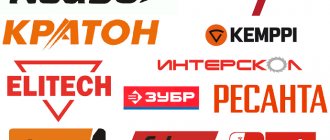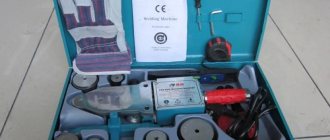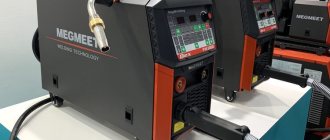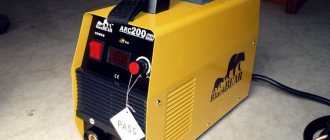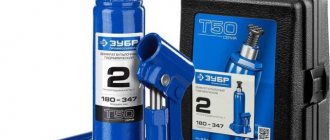Welding allows you to obtain permanent connections that are exceptionally strong. This indicator at the seam must be no lower than the base material, which is achieved by strict technology requirements and the addition of alloying substances. In addition, this process is characterized by connection speed, complexity of the acceptable form, and the ability to control and vary basic parameters. MIG/MAG welding is developing most dynamically in industrial applications, but other types are also being improved. The choice of a specific approach is determined by a number of parameters:
- Material of the parts to be connected.
- Production conditions. MIG, MMA and TIG require different organization and production preparation. The set of necessary equipment can vary from a simple power source to a set that includes a feed mechanism with precise adjustment and a compressed gas cylinder.
- Quality requirements. MIG, MAG, MMA and TIG welding should not always be considered interchangeable - they have different capabilities, including in the formation of the weld.
- Personnel qualifications. The most accessible in this are MAG and MMA. However, RDS is noticeably more difficult with increased requirements and small dimensions: leg, width, height, etc.
- Expected performance. The semi-automatic and automatic process turns out to be much faster than the manual one. Depending on this, suitable types are considered and the optimal one is selected.
MMA
mma technology diagram
In our country, the definition of manual arc welding (and the abbreviation RDS) is common. It is cheaper and easier to organize production and less demanding on equipment.
The connection of two elements in MMA occurs using an electrode - a metal rod coated with a coating containing substances that help maintain the arc, protect the welding zone, and form a seam with the desired properties. When voltage is applied, a stable short circuit is formed between the rod and the workpiece, leading to their mutual melting.
The difficulty may come from requiring welder qualifications. To obtain a neat and reliable joint, skill and long experience are required.
In MMA, special attention is paid to the condition of the electrodes, which should not be wet or crumbling. Do not neglect pre-drying and checking.
Summary
Despite the additional benefits that the TIG method provides, it is not necessary for domestic use.
Considering the additional costs of gas-cylinder equipment and its bulkiness, inverters with combined functions are optimal only for professional use - not a single service station can do without argon arc welding.
When choosing a device that supports MMA/TIG modes, you should study the operating history of the model - user reviews are the most optimal evaluation criterion.
MIG/MAG
Mig/mag technology diagram
The question of what MIG/MAG welding is should not be misleading, despite the unusual designation.
The English abbreviation MIG/MAG (MIG/MAG) hides the well-known semi-automatic welding with electrode wire in a shielding gas environment.
Instead of a rod, a thin wire acts as an electrode, which is semi-automatically fed into the zone where the weld is formed. This compensates for the melting process and simplifies the performer’s task.
Small diameter wire (from 0.8 to 3.0 mm) allows you to obtain compact connection sizes of a few millimeters.
Fundamentally, MIG differs from MAG in the type of protective gas, which is necessary for isolation from the environment with its high oxygen content in the air. Oxidative processes negatively affect the structure through the formation of intercrystalline rust. MIG welding involves the use of inert gas, which itself does not enter into any chemical reactions, but due to its relatively large weight, tends downward, displacing air. A local microclimate is formed, which shows good results.
MAG welding involves interaction between the natural and created environments, accompanied by the binding of oxygen.
Operating modes
A welding machine with four modes (MIG, MAG, TIG, MMA) opens up wide possibilities. It allows you to create a seam in different positions, weld ferrous and non-ferrous metals, galvanized, thin and thick sheets.
Spot/Stitch
“Dot/stitch” - this is how you can translate the name of the mode. In it, the MIG MT 250 welds with stitches. The welding drop is transferred when there is no short circuit, which reduces heat input into the product being welded. This eliminates overheating and warping of the metal.
The mode is used when welding galvanized products and stainless steel. Reduced heating of the electrode and the part allows you to increase the performance of the device and its service life.
MIG/MAG
In MIG and MAG modes, the welding machine operates semi-automatically. The filler wire is fed evenly with the simultaneous supply of shielding gas.
The welder only has to move the torch along the future seam at a certain height from the part being welded. This ensures a high welding speed and a high-quality weld, thanks to protection from air oxygen by inert gas. The welding current can be adjusted over a wide range from 30 to 250 A.
TIG
Unlike most semi-automatic MIG MAG devices, the MIG MT 250 model can weld metals in TIG mode using direct current. The device provides for rapid ignition of the electric welding arc when the end of the electrode touches the part to be welded.
MMA
Traditional manual electric arc welding provides welding of ferrous metals and their alloys. Direct current allows you to obtain a stable arc.
A special function of the ARC-FORCE welding machine provides adjustment of the arc power, which allows you to obtain the required parameters and a high-quality weld.
TIG
Tig technology diagram
The decoding of this abbreviation leads to welding with a non-consumable electrode in an environment of inert gases. The main welding material used is thin, sharpened tungsten rods that are strong enough not to melt at operating temperatures. Wire is used as an additive, but its presence is not a prerequisite.
The argon-based protective environment not only sets the correct casting processes, but also creates a melting zone that is local and deep.
TIG is demanding on the level of the welder and on the equipment. Due to its minimal heating, it is usually used to work with aluminum or thin-sheet stainless steel. The same applies to MIG welding.
Flux
Among the types of arc welding, in addition to MIG MMA TIG, it is also worth mentioning that it proceeds under a layer of flux. What flux is has many variations. All possible materials have in common such qualities as flowability, the ability to influence the formation of a seam at all stages of remelting (including under unfavorable external conditions), and the ability to form a monolithic crust after cooling. The use of flux shows very good results, but complicates the process itself and implies additional costs. MIG, TIG and MAG are more economical and easier to implement.
Comparison of MMA and TIG welding inverters
The use of welding inverters for various purposes has led to the need for the development of several types of welding. The most used mode is coated electrode welding (English abbreviation MMA). The argon arc version (TIG) is used less frequently, but is no less popular.
To operate in MMA mode, electrodes are required, which are replaced as they are used up. For argon arc welding you will need a gas torch, an argon cylinder and a fireproof tungsten electrode.
The advantages of welding in the TIG mode are the ability to fully work with very thin structures and products made of non-ferrous metals. The resulting seam is more accurate, and the welding itself requires less energy.
The disadvantages are associated with the bulkiness of the equipment and the inability to fully work with massive structures. Most welding inverters are produced in combination and include both modes.
Is it better to weld with semi-automatic or conventional welding?
Efficiency and speed of semi-automatic welding
much higher, and you can weld with it not only thick parts, but also thin-sheet iron.
During operation, there is no need to take a break to change the used electrode. Each type of welding
has its own advantages and disadvantages.
Interesting materials:
How fast does a hedge grow? How fast do violet babies grow? How fast do spruce trees grow? How fast do violets grow? How fast do hyacinths grow? How fast do gladioli grow? How fast do apple trees grow? How quickly do cacti grow from seeds? How fast do cypress trees grow? How fast do baby goats grow?
What to consider before purchasing a device
Before purchasing an inverter welding machine, pay attention to the following nuances:
- Does the equipment have protection against voltage surges? An inverter-type semi-automatic welding machine must be protected by 20-25% if it is intended for industrial production, and by 10-15% if it will work in domestic conditions.
- It is advisable to choose a welding inverter with tunnel ventilation. We remind you that dust is one of the most common causes of breakdown of even the best inverter-type welding machines.
- What protection class do the most popular models have? As a rule, the rating of the best welding inverters includes devices with degrees of protection IP22 and IP23. The ventilation openings are protected from the ingress of solid objects by special visors.
- At what temperature can the device be used? As a rule, inverter welding is not possible at temperatures lower than 0 degrees Celsius.
- What is the performance of the device? The voltage can be 220-230 V or 170-270 V. It is better to choose a welding inverter with a power reserve.
- Conditions in which the inverter will operate: domestic with a light load, in production with an 8-hour operating time, or intensive operation over 3 shifts.
- Is there a service center from the manufacturer in your region, since even the best welding inverters can sometimes fail.
Exclusivity of the EWM tigSpeed drive 45 feeder
Having considered the general requirements for equipment for high-speed welding of aluminum, I would like to dwell a little on the expanded capabilities of the EWM tigSpeed drive 45 feeder. In addition to the above-described property of feeding the additive with oscillatory movements that imitate the welder’s hand, welding with hot or cold wire is possible here.
TIG welding with cold wire gives high speed, and the equipment is cheaper. This is beneficial for the quick assembly of leaking structures. TIG hot wire welding involves additional, resistive heating of the additive from a separate current source. Optimal heat balance increases the melting power by 60% and allows deeper penetration of the material, while maintaining a high process speed and a small weld width. This will be useful for enterprises that produce critical products (collectors, chemical containers, etc.), which undergo mandatory testing with a flaw detector.
Other advantages of the EWM feeder include:
- 4 rollers for rolling without slipping;
- the feed speed is 2 times higher than similar manual manipulations;
- Suitable for any EWM device manufactured after 2003;
- Compatible with water cooling for extended runtime;
- helps reduce harmful flue gases;
- Provides a perfectly smooth seam surface without spattering.
Applications and Benefits
Such equipment can be used in the same way as welding aluminum TIG or MIG separately. These are auto repair shops, mechanical engineering, ship repair, food and chemical industries (tanks, collectors, filters, highways, etc.). But thanks to the automatic feed of filler wire, welding processes will be completed faster. Since the arc burns between the tungsten electrode, it does not “walk” and is easier for the welder to control. The specialist has a free second hand with which to support the workpieces. There is no need to regularly unwind the wire from the spool and twist it into a more compact skein. All this increases the productivity of your enterprise.
For example, in production there will be no need to hire an additional group of welders and buy equipment for them in order to increase the volume of output. This can be done by the same workforce, provided they use a combination of EWM Tetrix AC/DC + TigSpeed devices and a specially configured burner.
Main manufacturing companies
There are a large number of manufacturers of welding units at the present stage, but not all have gained the attention of consumers. If you are wondering which device to choose from, check out the most popular manufacturers:
- Aurora. A company that emerged as a result of a collaboration between the Northern European organization AURORA Group of Companies and the Chinese manufacturer RILAND Industry. In addition to welding equipment, the company produces generators, compressors, pumps, and garden equipment.
- Svarog. The official distributor of the Chinese corporation Jasic Technology Company Ltd, supplying welding equipment and components for it since 2007.
- Elitech. Trademark that emerged in 2008. The company supplies compressors, trimmers, metal processing machines, welding and garden equipment from the brands Bosch, AEG, Black&Decker, Makita and others.
- ESAB. A Swedish brand with branches in 47 countries and its history dating back to 1907.
- Cedar. The Russian company manufactures equipment based on American welding equipment. Despite the fact that the company has been on the market for only 7 years, its products are supplied to more than 100 European enterprises.
- Fubag. This German company has been in the professional equipment market for more than 40 years. Inverters are manufactured in 19 factories in accordance with international ISO standards.
- Interskol. A Russian manufacturer that has been actively producing household and professional tools since 1998.
The rating of welding inverters for home among welders consists of both domestic and foreign equipment. Note that when purchasing the best inverter welding machines, you should not give preference to devices made exclusively in Europe or America: most devices from well-known brands are made in Asian countries. Therefore, a product from, for example, a well-known Chinese manufacturer may turn out to be no worse.
Semi-automatic welding
The choice of equipment for a welder is huge. The MIG MAG welding machine is very popular. It is used in almost all auto repair shops due to the high quality weld it produces.
Most welding machines now use inverters. The frequency of the welding current in them is practically independent of changes in the mains voltage. At the same time, they have compact dimensions and weight, which allows them to be mobile.
Since the power source for most types of electric arc welding has the same parameters, manufacturers began to create universal models capable of operating in different modes and different types of torches. Semi-automatic MIG MAG and TIG welding has especially developed.
Interesting “symbiosis” of equipment
If it were possible to weld aluminum parts as accurately as TIG and as quickly as MIG, the quantity produced would increase without sacrificing quality, which would help increase profits. Is there a technological solution for this?
Yes, I have! This is a bundle of equipment that includes: EWM Tetrix 351 AC/DC inverter + EWM tigSpeed drive 45 coldwire feed mechanism + special burner. Thanks to this set, TIG welding is carried out using alternating current, but instead of manually supplying the additive, an automatic one is used, on top of a nozzle with a tungsten electrode. This ensures process continuity, high execution speed and better quality.
Welding wire
Semi-automatic MIG MAG TIG welding involves the use of welding wire, which is threaded into the machine. The quality of the seam also depends on its characteristics. In some cases, you can even do without shielding gas when using cored wire.
There are four types of additives: aluminum, steel, copper and powder. The last two are the most popular. Their use guarantees no splashes and high productivity.
In addition to cored wire, filler wire must be used in a protective gas atmosphere. When purchasing, be sure to check compatibility with the materials and tips being welded.
Rating of the best models
Below are several argon welding machines that have proven themselves in their work.
Gigant TIG-200
The Gigant TIG-200 is a low-cost, affordable welding machine. It costs in the range from 15,000 to 17,000 rubles, so it is accessible to almost everyone.
Here are the main technical characteristics of this device:
- The maximum possible power is 7,100 W.
- The maximum possible current is 200 A.
- Overall dimensions 45 x 25 x 33.5 cm.
- Power source: household electrical network with a voltage of 220 V.
- Weight 10 kg.
Thanks to its high power and current, which can be up to 200 A, the Gigant TIG-200 can weld metal sheets up to 5 mm thick.
There is a pulse mode that significantly increases the efficiency of the device.
The holder has an air radiator that effectively cools it and prevents overheating.
The main unit housing has IP21S level protection. This means that the holes that are located there cannot be used to insert fingers or other similar-sized objects, and also that the equipment is not afraid of small splashes of water getting onto the outer surface.
TIG technology is supported (that is, it is possible to use both direct and alternating electric current). This significantly expands the scope of application of Gigant TIG-200, making it possible to work with most existing alloys.
The device has two configurations:
FUBAG INTIG 200 AC/DC PULSE
FUBAG INTIG 200 AC/DC PULSE is an expensive professional welding machine. It is not cheap - the price for this device is about 70,000 rubles.
Here are the technical characteristics of this device:
- The maximum possible power is 6,600 W.
- The maximum possible current is 200 A.
- Overall dimensions 54 x 24 x 30 cm.
- Power source: household electrical network with a voltage of 220 V.
- Weight 10.5 kg.
The equipment has the ability to switch to a pulsed electric arc mode. In this case, both two-stroke and four-stroke operation are possible. Switching to AC operation is also available.
Unlike the Gigant TIG-200, the FUBAG INTIG 200 AC/DC PULSE is not protected against splashing water, so use the equipment in rain or in conditions where it is possible to get wet with great care
Svarog TIG 180 DSP PRO W206 00000091580
Svarog TIG 180 DSP PRO W206 00000091580 is a mid-price welding machine from a domestic manufacturer.
Here are its main technical characteristics:
- The maximum possible power is 5,000 W.
- The maximum possible current is 200 A.
- Overall dimensions 36.5 x 13.5 x 27.7 cm.
- Power source: household electrical network with a voltage of 220 V.
- Weight 6 kg.
The device has IP21 level protection, which protects it from small splashes of water and foreign objects entering the housing.
A distinctive feature of the Svarog TIG 180 DSP PRO W206 00000091580 model is the ability to reduce the current to just 10 A. This allows you to effectively work with thin workpieces, the thickness of which is 1.5-2 mm.
Pulse arc mode is available (two-stroke or four-stroke).
Svarog TIG 180 DSP PRO W206 00000091580 works only with alternating current. This somewhat reduces the efficiency of processing steel and copper, but is not critical.
Another advantage of Svarog TIG 180 DSP PRO W206 00000091580 is its low weight, which is only 6 kg. The dimensions of the device are also small. This makes it possible to take the equipment to any place, as well as easily transport it not only in a car, but also in public transport.
